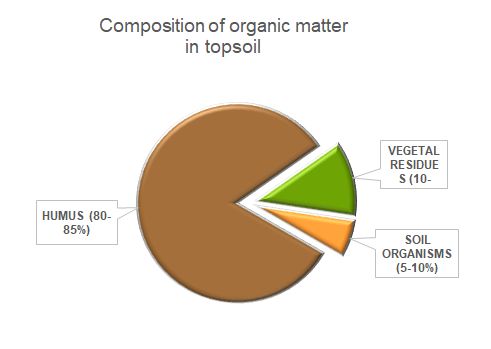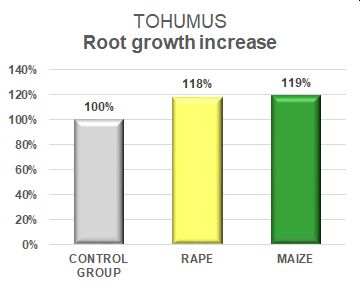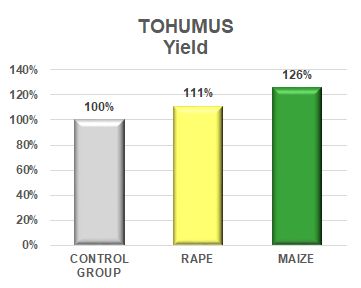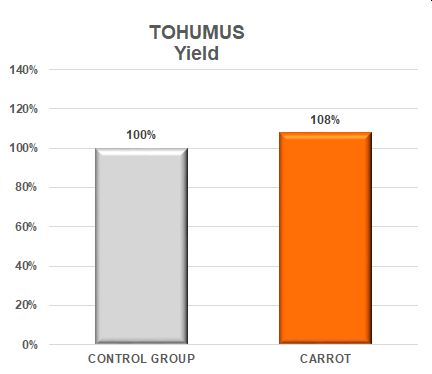In Poland, natural factors, primarily the climate, a large share of sandy soils and soil acidification, do not promote humic substances, main components of soil organic matter, being accumulated and kept at the same level.
A 0.5% increase
Humus is the main component of the organic matter in arable soils, one of the most important factors determining soil fertility that has impact on plant growth, yield and its quality.

Humic substances are conducive to the functions and properties of organic matter. They are composed of humic acids, fulvic acids and humins. These substances are produced during microbiological and chemical decomposition of vegetal residues (humification). Humic acids belong to a group of humic compounds containing approx. 58% of carbon. These compounds are not soluble in an acidic environment. They are dark brown to black. Fulvic acids contain approx. 55% of carbon. They are yellow to yellow-brown and easily soluble regardless of pH. Humins are dark-coloured humus compounds, insoluble in water, regardless of pH. They determine humus stability in the soil.
Humic acids show high water capacity, and are capable of sorbing and desorbing cations contained in the soil, regulating their release. At the same time they help maintain the optimal pH of the soil. They favourably change thermal parameters of soils. Humic acids present in arable land may have a stimulating effect on the life processes of soil organisms and plants as well as accelerate decomposition of environmental pollutants.
With humic acids used in plant production it is possible to yield more food of better quality. Incorrectly performed agrotechnical treatments along with biomass being removed from the fields without manuring makes soils less abundant with humus, and thereby with humic substances naturally occurring in the soil. Supplying humic compounds into the soil is one of the methods to increase production of food with good quality parameters while maintaining soil fertility.
Taking into account the considerations above, a humic preparation should be supplied in form of humic acid salts, which ensure rapid action thanks to their solubility in water.
The humus content in Polish soils varies and depends on soil type and how it is used. The study carried out by National Research Institute of Soil Science and Plant Cultivation (IUNG-PIB) as part of the Monitoring of the Chemistry of Polish Arable Soils (2017) revealed that average humus content is 1.94%. This report shows that degradation of organic matter significantly differs among individual regions (a positive balance of organic matter was recorded only in Podlaskie and Warmińsko-Mazurskie provinces, while the highest estimated degradation was observed in Dolnośląskie and Opolskie provinces). Comparable studies conducted by IUNG-PIB in Puławy of 1000 model profiles analysed recently and in the 60s and 70s revealed that an increasing amount of organic matter is lost in Polish soils. According to these studies it is estimated that over 0.8% of organic matter will on average be degraded in soils in Poland by 2030.
Soil humus is a factor determining water retention in arable layer. It is capable of retaining 3-5 times more water in form that is available to plants than the mineral fraction. An increase in the content of humic substances in the soil by 0.5% makes it possible to additionally retain approx. 80 m3 water/ha, which corresponds to 8 mm of each rainfall that can be used by plants. While estimating an anticipated average decrease in the organic matter content on agricultural land by 0.8% by 2030, including 18.9 million ha in Poland, it can be expected that periodic water retention capacity will decrease by 245 million tonnes of water.
In order to meet the growing needs of the changing agriculture, Grupa Azoty is introducing a new, environmentally safe product to the market.
Tohumus is an organic and mineral plant growth promoter derived of brown coal, being a biological and natural raw material.
Tohumus is produced during alkaline extraction from brown coal mined in strip mines.
COMPOSITION OF THE PRODUCT:
Tohumus is a potassium salt of humic acids (so-called potassium humate).
Humic acids: approx. 7%
Potassium: approx. 1%
pH: 9-11
BENEFITS
Thanks to Tohumus a higher concentration of nutrients is kept near the roots, making plants use nutrients more efficiently.
Benefits associated with Tohumus:
- higher yields;
- greater growth of above-ground plant parts;
- increased development of the root system, including in particular hairy roots (higher nutrient and water uptake);
- increased root elongation and vigour (a plant is able absorb water from deeper layers of soil and make better use of nutrients);
- increased natural resistance of plants to diseases (limited source of primary infections);
- improved yield quality;
- promoted production of chlorophyll, sugars and amino acids in plants and photosynthesis.
Positive impact on soil fertility by:
- increasing water capacity, of light soils in particular, thereby reducing a risk of drought;
- creating a lumpy soil structure – good relation between air and water;
- increasing availability of nutrients for plants;
- reducing the quantity of elements rinsed out and retaining them near the roots (better uptake by the cultivated plant);
- maintaining an appropriate content of organic matter;
- showing greater absorption of solar energy, and thereby ensuring better thermal properties (which has an impact on how nutrients are released from the soil);
- supporting development of beneficial microorganisms;
- supporting decomposition agricultural (organic) crop residues; the nutrients released as a result of its transformations become faster available for plants;
FIELD TEST RESULTS
Field tests on winter oilseed rape and maize showed that root size increased by 18% and 19% in case of oilseed rape and maize, respectively, after application of TOHUMUS, as compared to the control group without growth promoter (Studies conducted by IUNG-PIB in Puławy, in 2017-2018).
Furthermore, seed yield significantly increased by 11%, whereas above-ground parts of maize (intended for silage) grew by 26% as compared to the control group (Studies conducted by IUNG-PIB in Puławy, in 2018-2019).


Effectiveness of Tohumus as a plant growth promoter has also been confirmed in field cultivation of carrots. By applying the promoter to the soil before sowing, marketable yield increased by 8% compared to the control group (Studies conducted by National Research Institute of Horticulture in Skierniewice, 2018).

APPLICATION RULES
Tohumus should be used according to the instructions for use.
The product is in particular recommended for use in soils with low humus content, which are not manured, and at farms with simplified crop rotation with cereals predominating.
Instructions for use
|
Item |
Application method |
Dose TOHUMUS |
Application date |
Recommended amount of water |
|
Field crops |
Applied to the soil |
20-40 L/ha |
Use before sowing/planting. Preferably mix with soil. |
200-400 L |
|
Applied on the leaves |
20-40 L/ha |
One or two applications in the intensive growth period. |
200-400 L |
|
|
Vegetables |
Applied to the soil |
40 L/ha |
Use before sowing/planting. Preferably mix with soil. |
200-400 L |
|
Applied on the leaves |
20-40 L/ha |
One to three applications in the intensive growth period. |
200-500 L |
How to prepare working solution
Shake well before use. Determine the exact amount of the liquid before starting to prepare it. Measure out the right amount of product. Then pour it through a sieve into the sprayer tank half filled with water with the agitator switched on. Rinse empty packaging three times with water and pour washings into the sprayer tank with the working liquid. Then fill the tank with necessary amount of water and mix thoroughly. Wash the sprayer tank thoroughly after work.
The results of numerous studies have made it possible to understand the mechanism of the solution, and field implementations have shown its very high effectiveness in improving plant productivity and yield quality.
8%
Increase in the commercial yield of carrots
11%
Increase in the yield of winter rape
26%
Increase in aboveground mass of maize intended for silage